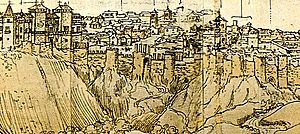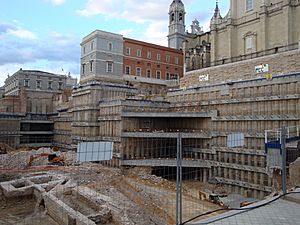Muslim Walls of Madrid facts for kids
The Muslim Walls of Madrid (also known as the Arab Walls of Madrid) are some of the oldest buildings still standing in Madrid, the capital city of Spain. They were built in the 9th century when Muslims ruled the Iberian Peninsula. These walls were part of a strong fortress next to the Manzanares River. This fortress was the very beginning of the city of Madrid. In 1954, these ancient walls were officially recognized as an Artistic-Historic Monument.
The walls were built in what is now called the Mohamed I Park. This park is named after Muhammad I of Córdoba, who is believed to have founded the city.
Along Calle Mayor street, at number 83, you can still see parts of the Tower of Narigües. This tower was likely a special lookout tower, connected to the main wall but standing a bit apart.
Sadly, some parts of the walls were destroyed in the 20th century. For example, some sections near Calle de Bailén were lost when a new apartment building was constructed. However, some parts of the walls were used in the building's foundations. When Plaza de Oriente was redesigned in 1996, many more parts of the walls were found and then removed. But one important watchtower, called the Tower of the Bones, had its base saved and is now on display in the underground car park of the plaza.
Between 1999 and 2000, another long section, about 70 meters (230 ft) long, was discovered under the Plaza de la Armería. This area is between the Royal Palace and Almudena Cathedral. This section was found during the building of the Royal Collections Gallery and might have been part of the Puerta de la Sagra, one of the old gates.
Contents
Why Walls Were Important
Cities in Muslim Spain

In Muslim cities, walls were very important. They helped protect the city's main area, called the medina. The medina usually had the main mosque and public baths. Walls kept the city safe from outside attacks and even from problems within the city's neighborhoods.
The walls also helped control who entered and left the city through its gates. This made it easier to collect taxes. So, the city was divided into the medina (the religious and business center) and the rabad (the busy neighborhoods outside the walls). The walls and their gates also helped shape how the city grew, with streets and neighborhoods forming around them.
Madrid's Early History

The Muslim Walls are directly linked to how Madrid began. They were ordered by the Muslim ruler Muhammad I of Córdoba sometime between 860 and 880 AD. The location was chosen carefully: a wide valley with easy access to water. The walls protected the almudaina, which was the Muslim fortress of Mayrit (Madrid's first name). This fortress stood where the Royal Palace is today.
Old Muslim writers said the walls were built very well. A historian from the 17th century, Jerónimo de Quintana, wrote that they were "very strong of masonry and mortar, raised and thick, twelve feet [almost three and half meters] in width, with large cubes, towers gatehouses and moats."
The main job of this fortress was to watch over the Manzanares River path. This path connected the mountains with Toledo. It was a key route that Christian kingdoms from the north might use to attack. Madrid was like a military outpost, also serving as a religious community.
The walls of Mayrit were part of a bigger defense system in the Community of Madrid. Other fortified places included Talamanca de Jarama and Alcalá de Henares.
In the 10th century, the ruler of Córdoba, Abd-ar-Rahman III, ordered the walls to be made even stronger. This was after the Christian King Ramiro II of León attacked in 932. Later, in 977, Almanzor started his military campaigns from the fortress of Mayrit.
When Christians took over Mayrit in the 9th century, the original walled area was made bigger. This new, larger wall is known as the Christian Walls of Madrid. So, Madrid always kept its strong defensive role.
An important statue of the Virgin Mary, called the Virgin of Almudena, was found in 1085. This happened when King Alfonso VI of León and Castile conquered the city. The statue was found in one of the wall's towers, near the Puerta de la Vega gate. It was then placed in the old mosque for people to worship.
What the Walls Looked Like
General Information
The Muslim Walls of Madrid protected a fortified area. Inside, there were three main buildings: the alcázar (fortress), the mosque, and the home of the ruler.
The walls started directly from the southern part of the alcázar. The other three sides of the alcázar didn't need strong walls because the land was naturally protected by steep cliffs and ravines.
The total length of the walls was about 980 meters (3,215 ft). They enclosed an area of about 4 hectares (10 acres). There was a ditch (moat) outside the walls, but only on the eastern side where the ground was higher.
Outside the main walls, there were also separate watchtowers. We only know about one called the Tower of the Bones. It was named because it was near a cemetery. This tower was built in the 11th century and later became part of the Christian Walls of Madrid.
Outside the walls, there were also public areas for fun and horse games. There was a Muslim neighborhood and a Christian neighborhood.
Gates of the Walls

The walls had three main gates, which allowed direct entry without any turns:
- The Puerta de la Vega was located in the area of Cuesta de la Vega today. It connected the fortress with the plains of the Manzanares River and roads leading to Castile and Extremadura. It might have been where the statue of the Virgin of Almudena is now, near the cathedral.
- The Puerta de la Mezquita, also called Arco de Santa María, led to the city's main area outside the fortress, through what is now Calle Mayor.
- The Puerta de la Sagra, or de la Xagra, or del Campo, led to the gardens. It was located near the current Calle de Bailén and Plaza de Oriente.
Archaeologists have found the most information about the Puerta de la Vega. They found the foundations of one of the towers that stood next to this gate. The entrance was about 4.5 meters (14.8 ft) wide and 3.5 meters (11.5 ft) tall.
Towers of the Walls
The wall had many square-shaped towers. They were between 3.3 and 2.4 meters (10.8 and 7.9 ft) wide and stuck out slightly from the main wall. These towers were placed about every 20 meters (66 ft). The walls between the towers were made of flint and limestone stones.
The best-preserved section of the walls is in Mohamed I Park. Here, the towers are about 20 meters (66 ft) apart. There are six towers visible, though one is only marked by its base. The shape of these towers helps confirm they were built by Muslims. Christian towers usually had a rounder shape.
Where You Can See the Walls Today
Mohamed I Park
This is the most important and easiest part of the walls to visit. Excavations here in the 1970s and 1980s revealed a lot of information. A 19th-century building that stood on top of this section was removed, allowing the walls to be seen and restored.
About 120 meters (390 ft) of the wall are visible here. This part of the walls survived because it was used as a strong supporting wall for newer buildings. When those buildings were taken down, the old wall was uncovered. Many parts of the walls were also rebuilt or changed over time.
This section of the wall is about 2.6 meters (8.5 ft) wide. It has two outer walls with stones and lime mortar in the middle. The materials used, like flint and limestone, were found close to the city. This shows how important the location of the Islamic city was.
The bottom parts of the walls are made of large flint blocks. Above these, there are ashlars (cut stones) of limestone. This style of building is typical of al-Andalus (Muslim Spain).
Calle Bailén 12
The building at Calle Bailén number 12 was built on top of parts of the walls. Even though the walls were already protected as an "Artistic Historical Monument" in the 1970s, two sections of the walls and a tower were destroyed to make way for the building and its residents.
However, the building still has some small parts of the walls in its private garage. These remains are very similar to those in Mohamed I Park, as they are an extension of the same wall.
Even with the destruction, some records were made. We know this section was about 2.5 meters (8.2 ft) wide. It also gave archaeologists a chance to study the inside of the wall, providing information about its core made of lime mortar and masonry.

Royal Collections Museum
Another large section of the Arab walls was found in the late 1990s. This part is directly across from the Almudena Cathedral. These remains were uncovered during the construction of the Royal Collections Gallery. Since it was hard to dig in this area, experts used special detectors to map the wall's path without digging up the pavement.
There are two sections from the Islamic period here, totaling about 70 meters (230 ft). The materials and building methods are the same as other parts of the wall. However, this section is thicker, averaging over 3.2 meters (10.5 ft) wide. In one part, the wall's height was found to be around 7 meters (23 ft), though other parts are completely destroyed.
Discovering the Walls
Before 1985, archaeologists in Madrid mainly focused on visible structures like old fortresses or churches. But for the Muslim Walls, archaeological work has been happening since the late 1700s and early 1800s.
In the 20th century, more progress was made. The Madrid Archaeological Institute worked to protect the walls in the 1960s and 1970s, as they had been declared "monuments." They carried out digs in areas like Cuesta de la Vega and Calle Mayor.
Because many parts of the Muslim Walls were hidden, it was hard to find them. Since 1985, more digging has been done on the Cuesta de la Vega. This led to the discovery and preservation of the most important section of the walls, which is now part of Mohamed I Park.
See also
 In Spanish: Muralla musulmana de Madrid para niños
In Spanish: Muralla musulmana de Madrid para niños



